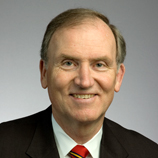United Germany at 25
AGI is pleased to present this collection of essays reflecting on the 25th anniversary of German unification in October 2015. We are grateful to those who have contributed to this collection, all of whom have been affiliated with and supported the Institute in many different capacities. These essays leave us with thoughts not only about the past, but also about the future of German-American relations. Be sure to check back throughout the week for additional insights.
It was with deep emotion that I watched from the State Department as the dramatic events of November 9, 1989, unfolded. My parents had met and married in Berlin after World War II; I had visited Berlin as an Army dependent and military officer both before and after the Wall went up; and I had hoped but never really expected to see the Wall fall in my lifetime.
Even when the barbed wire was cut between Hungary and Austria in the spring of 1989, few would have predicted the rapid turn of events to come. One who did was my predecessor as Ambassador to Germany, Vernon (Dick) Walters, who said shortly after his arrival in Bonn in the spring of 1989 that he expected Germany to unite during his time as ambassador.
President George H.W. Bush visited Germany later that spring, and in Mainz called for Germany to join the United States as a “Partner in Leadership.” Germans reacted with mixed emotions to these words, with many hearing “Partner” less loudly than “Leadership” (Führung), a word that still evoked haunting memories 44 years after the end of the war.
When the Wall fell, President Bush was asked whether he was going to fly to Berlin. His response was that this was a moment for the German people—and, he asked, “What am I supposed to do: dance on the Wall?” Beneath this levity was a sober assessment on the president’s part of the difficult path ahead, one in which Soviet participation was absolutely essential. There was no place for triumphalism.
But, interestingly, the president was also secure in his belief that he had already set the U.S. strategic direction on German unification—and had done so two weeks before the Wall fell. In an interview with R.W. Apple of The New York Times on October 24, 1989, the president expressed confidence in Germany, saying that “Germany’s commitment to and recognition of the importance of the alliance is unshakable.” Confidence in Germany and Germany in NATO: the strategic touchstones to all that followed.
When I arrived in August 1991 as the first American ambassador appointed to a united Germany in over 50 years, the euphoria of unification had begun to fade. The Bundestag had just voted by a narrow margin to move the seat of government back to Berlin; the true costs of unification were becoming apparent; and the conflict in Yugoslavia was growing in intensity.
Germany was beginning to turn inward, hesitating not only on leadership, but even on participation. My message on behalf of the U.S. government was clear: Germany was as important to U.S. and transatlantic interests in this new era as it had been as the front-line nation of the Cold War. And the bilateral relationship, while still maintaining important diplomatic and military dimensions, needed also (using Helmut Kohl’s words) to add “new lanes to the transatlantic bridge” by placing greater emphasis on commerce and culture.
In the years that followed, Germany and the United States began to broaden and deepen their already close ties. Germans working in Germany for American companies grew by the tens and eventually hundreds of thousands (today over 600,000), with corresponding increases in the number of Americans working in the United States for German companies. So, as the U.S. military stationed in Germany declined from over 250,000 to under 50,000, these military forces (Streitkräfte) were replaced in almost exact numbers by private sector workers (Wirtschaftskräfte).
Germany also went through a wrenching but ultimately successful debate on the use of German military forces outside the geographical NATO area (with Greens leader Joschka Fischer playing a key role). German forces subsequently served shoulder-to-shoulder in difficult Alliance operations in the Balkans, Afghanistan, and elsewhere.
This stronger foundation for the bolstered relationship turned out to be especially important as our two countries went through difficult times during the Iraq War, and, more recently, after the Snowden/NSA revelations. Today, both countries are working to address these differences while at the same time advancing transatlantic, European, Alliance, and global priorities:
- Transatlantic: With Chancellor Angela Merkel’s initiative and leadership, trade talks between Europe and the United States have progressed further than ever before. The Transatlantic Trade & Investment Partnership (TTIP) has the potential to be as important to the future of the Alliance as the North Atlantic Treaty creating NATO has been to its past.
- Europe: Since the beginning of the euro zone crisis in 2010, Germany, led by Chancellor Merkel and Finance Minister Wolfgang Schäuble, has been in the lead on shaping the European response. Although criticized by many in Europe, and the United States, for being too doctrinaire on austerity, Germany believes it is asking others to take only those difficult steps Germany had already taken on labor market flexibility (in Gerhard Schröder’s Hartz reforms) and fiscal discipline.
- Alliance: Germany, and especially Chancellor Merkel, has been in the lead on Alliance efforts to respond to Russian aggression in Crimea and eastern Ukraine. Without German leadership, European sanctions against Russia would not have been as strong or cohesive.
- Global: In the “Perm Five plus One” nuclear agreement with Iran, it is Germany who is the very influential “plus One.” On Iran and beyond, Germany has become a de facto permanent member of the UN Security Council, respected by both the P5 and the rotating members of the Security Council. This important trend is consistent with President Joachim Gauck’s call for Germany to play a more active global role.
Coming full circle after 25 years, today’s Germany is becoming the “Partner in Leadership” that President George H.W. Bush had envisioned. This maturing leadership role is good for Germany and Europe; for the United States and NATO; and for the United Nations and the world. And that is both a legacy and a promise on which to build.
Robert M. Kimmitt was American Ambassador to Germany from 1991-1993 and currently serves as Chairman of the American Council on Germany. He is a former member of AGI’s Board of Trustees.










